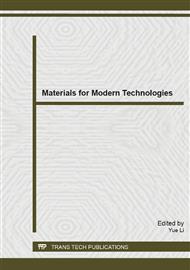[1]
X. Cheng, S.G. Roscoe, Corrosion behavior of titanium in the presence of calcium phosphate and serum proteins, Biomaterials 26 (2005) 7350–7356.
DOI: 10.1016/j.biomaterials.2005.05.047
Google Scholar
[2]
A. Bignon, Optimisation de la structure poreuse d´implants en phosphate de calcium pour application de complement osseux et relargage in situ d´un principe actif. Ph.D. Thesis, Institut National des Sciences Appliquées de Lyon, France, (2002).
Google Scholar
[3]
M. Jarcho, Calcium phosphate ceramics as hard tissue prosthetics, Clin. Orthop. Relat. Res. 157 (1981) 259–278.
DOI: 10.1097/00003086-198106000-00037
Google Scholar
[4]
S. Nath, R. Tripathi, B. Basu, Understanding phase stability, microstructure development and biocompatibility in calcium phosphate–titania composites, synthesized from hydroxyapatite and titanium powder mixtures, Mater. Sci. Eng. C29 (2009).
DOI: 10.1016/j.msec.2008.05.019
Google Scholar
[5]
T.M. Marcelo, V. Livramento, M.V. de Oliveira, M.H. Carvalho, Microstructural characterization and interactions in Ti-and TiH2-hydroxyapatite vacuum sintered composites, Mater. Res. 6 (2006) 65–71.
DOI: 10.1590/s1516-14392006000100013
Google Scholar
[6]
C.Q. Ning, Y. Zhou, On the microstructure of biocomposites sintered from Ti, HA and bioactive glass, Biomaterials 25 (2004) 3379–3387.
DOI: 10.1016/j.biomaterials.2003.10.017
Google Scholar
[7]
C.Q. Ning, Y. Zhou, Correlations between the in vitro and in vivo bioactivity of the Ti/HA composites fabricated by a powder metallurgy method, Acta Biomater. 4 (2008) 1944–(1952).
DOI: 10.1016/j.actbio.2008.04.015
Google Scholar
[8]
M. Karanjai, R. Sundaresan, G.V.N. Rao, T.R.R. Mohan, B.P. Kashyap, Development of titanium based biocomposite by powder metallurgy processing with in situ forming of Ca-P phases, Mater. Sci. Eng. A447 (2007) 19-26.
DOI: 10.1016/j.msea.2006.10.154
Google Scholar
[9]
J.Y. Lim, X.M. Liu, E.A. Vogler, H.J. Donahue, Systematic variation in osteoblast adhesion and phenotype with substratum surface characteristics, J. Biomed. Mater. Res. 68A (2004) 504–512.
DOI: 10.1002/jbm.a.20087
Google Scholar
[10]
X. Lu, Z. Zhao, Y Leng, Biomimetic calcium phosphate coatings on nitric acid-treated titanium surfaces, Mater. Sci. Eng. C 27 (2007) 700-708.
DOI: 10.1016/j.msec.2006.06.030
Google Scholar
[11]
G. Zhao, Z. Schwartz, M. Wieland, F. Rupp, J. Geis-Gerstorfer, D.L. Cochran, B.D. Boyan, High surface energy of SLActive implants enhances cell response to titanium substrate microstructure, J. Biomed. Mater. Res. 74A ( 2005) 49–58.
DOI: 10.1002/jbm.a.30320
Google Scholar
[12]
M. Lampin, W. Clérout, C. Legris, M. Degrange, M.F. Sigot-Luizard, Correlation between substratum roughness and wettability, cell adhesion and cell migration, J. Biomed. Mater. Res. 36A (1997) 99-108.
DOI: 10.1002/(sici)1097-4636(199707)36:1<99::aid-jbm12>3.0.co;2-e
Google Scholar
[13]
M. Wong, J. Eulenberger, R. Schenk, E. Hunziker, Effect of surface topology on the osseointegration of implant materials in trabecular bone, J. Biomed. Mater. Res. 29 (1995) 1567–1575.
DOI: 10.1002/jbm.820291213
Google Scholar
[14]
S. A Cho, K.T. Park, The removal torque of titanium screw inserted in rabbit tibia treated by dual acid etching, Biomaterials 24 (2003) 3611–3617.
DOI: 10.1016/s0142-9612(03)00218-7
Google Scholar
[15]
J.Y. Park, J.E. Davies, Red blood cell and platelet interactions with titanium implant surfaces, Clin. Oral Implants Res. 11 (2000) 530–539.
DOI: 10.1034/j.1600-0501.2000.011006530.x
Google Scholar


